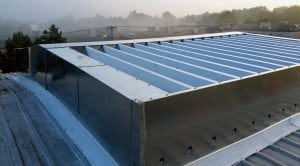Gravity Ventilation: A Manager’s Best-Kept Secret
Factory, warehouse, and operations managers that discover the secret of natural ventilation see cooler work floors, happier personnel, and lower operating costs. Overnight they see how gravity ventilation can impact their facility. Some managers keep this secret to themselves so as not to tip their hand. Unfortunately for them, we’re going to let the entire world in on the secret.
Top Secret Ventilation Tips
Natural ventilation is the best-kept secret in the world of industrial facility management. Many facility managers see powered ventilation as the only option for cooling their building. They don’t even realize that there is no other way, let alone understand the efficiencies that can be achieved through Pressure Gravity Ventilation®. While the concept dates back millennia it is only in the last few decades that we have figured out how to use it on a grand scale in a variety of environments.
A gravity ventilation system allows for a steady flow of air across the building’s work floor. This is supplemented by the air that enters at the ground level. Additionally, this constant flow of fresh air into the building promotes the expulsion of the hot, dirty air through the roof.
Intake Air Wall Louvers

Intake wall louvers and gravity roof ventilators, like the Low-Profile Vent are aerodynamically designed weather protected openings that promote the flow of air. An experienced ventilation design engineer knows how to place these devices to maximize airflow. A well-designed system will take advantage of gravity and the temperature differentials to result in a self-perpetuating non-powered ventilation system.
The key term in that last sentence, of course, was non-powered. Natural ventilation uses no power. It does not require electricity to operate. This eliminates the electrical costs of running exhaust fans. It normally costs around $600 per HP per fan, or $30,000 per year on a building with ten 5 HP fans. You can eliminate this cost entirely by switching to natural ventilation today. Of course, this doesn’t even include the additional maintenance and repair costs that come with fans. Or the downtime required to fix them. Or any of the other problems that pop up too often with exhaust fans. A gravity ventilation system eliminates those problems completely.
As a result, modern gravity ventilation technology grew out of the steel industry in the early 1900s. Massive vents exhaust the incredibly hot air that resulted from the molten metal processes. Forges and glass plants, followed by paper and gypsum plants, also began to use natural ventilation. As the technology constantly improves the ventilators become more effective as the technology improves. A wider variety of applications and industries use natural ventilation.
Gravity Ventilation Devices

The MatrixVent vents are so effective that they often work on moderate temperature buildings too. They work best on buildings with higher temperatures with higher roofs, but many plant managers have seen remarkable success installing them into smaller facilities as well.
On the other hand, when natural ventilation is not ideal, a Pressure Gravity System® or Hybrid Ventilation System might be the right choice. This type of system works like a passive exhaust system except it uses wall fans to provide supply air to the building. This produces a positive pressure environment pushing the air through the space at an increased rate. Of course, this requires electricity, but often a good deal less. Even better, as the fans are handling cool, clean air they require less maintenance as well. Often when the building has a lower roof or the process doesn’t generate quite as much heat, a Pressure Gravity System® is an effective alternative.
In conclusion, don’t miss out on the hidden benefits of a Natural Ventilation or Pressure Gravity System® system. Through the proper design of a Natural Ventilation System your facility can be more comfortable. Furthermore, your electrical cooling costs kept down to a minimum.
Fill out the form below to you uncover the Pressure Gravity System® solution for your facility today.
